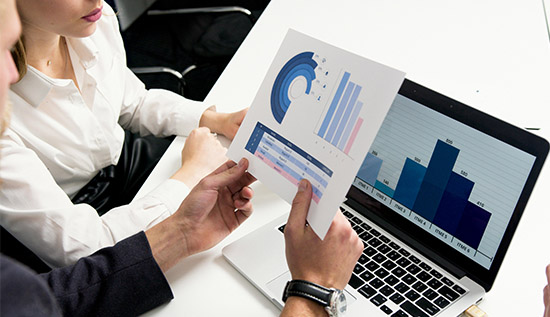What is Data Visualization? Tools, Technique and Importance

The power of data visualization. Tools, techniques, and why data visualization is important explained.
In the data-driven world of today, data visualization has become an indispensable tool for businesses, researchers and individuals alike. But what is data visualization? Simply put, it is the graphical representation of information and data.
People may understand complex data sets, see trends and make informed decisions with the use of tools and techniques by employing visual components such as charts, graphs and maps in the visualization of data.
This article will explore what is data visualization, it's objective the most efficient visualization of data methods and the greatest instruments for visualizing data. We’ll also discuss why data visualization is important and also give instances from everyday life to demonstrate its effects.
What is Data Visualization?
What is data visualization? It’s the process of translating raw data into a visual context, such as a chart, graph or map, to make it easier to understand and analyze. The primary goal is to communicate information clearly and efficiently.
For example, a sales team might use a bar chart to compare monthly sales figures or a healthcare professional might use a heatmap to track the spread of a disease. Through the presentation of information in an approachable and actionable manner visualization of data helps to close the gap between data and decision-making.
The main advantages of visualizing data are:
- Simplifies complex data sets.
- Reveals trends and patterns.
- Enhances storytelling with data.
- Supports faster and better decision-making.
What is the Purpose of a Data Visualization? Select All That Apply
When asking, what is the purpose of a data visualization? Select all that apply, the answers are multifaceted. The primary purposes include:
1. Simplifying Complex Data: Visuals make it easier to digest large amounts of information.
2. Identifying Trends and Patterns: Charts and graphs highlight relationships that might be missed in raw data.
3. Enhancing Communication: Visuals are universally understood making it easier to share insights.
4. Supporting Decision-Making: Clear visuals help stakeholders make informed choices.
A marketing team might, for example, utilize a line graph to monitor website traffic over time in order to pinpoint peak times and modify their approach accordingly.
Being aware of the objective of an information visualization. Making the right choices is essential to producing images that genuinely connect with your audience.
If you're presenting to executives or using your visualization to analyze data for a research project it should always serve the same purpose.
Types of Data Visualization
There are numerous types of data visualization, each is appropriate for various types of information and objectives. Typical forms of visualization of data include the following:
- Bar charts are useful for comparing quantities across categories.
- Line graphs: Ideal for displaying patterns over time.
- Pie charts are useful for representing proportions.
- Heatmaps are useful for showing density or intensity.
- Scatter plots are useful for displaying relationships between variables.
As an example, a scatter plot could assist a researcher in determining the relationship between advertising spend and sales revenue.
Another example of visualization of data is the use of geographic maps to display regional sales data. This type of depiction allows businesses to more efficiently deploy resources while also identifying high-performing locations.
Data Visualization Tools
The right data visualization tools may make all the difference in producing compelling pictures. Here are a few popular choices:
1. Tableau is an effective tool for creating dynamic dashboards.
2. Power BI is Microsoft's business analytics software.
3. Python Libraries, Matplotlib and Seaborn are excellent tools for displaying information in Python.
4. Google Data Studio is a free tool for creating personalized reports.
5. D3.js is a JavaScript library for creating dynamic web visualizations.
For example a data scientist may use Matplotlib and Python to create a histogram displaying the age distribution of clients also.
What is Data Visualization in Python?
It refers to the use of Python libraries like Matplotlib, Seaborn and Plotly to create visual representations of data. Python is frequently used for visualization of data due to its adaptability and extensive library support. Seaborn may be used to create heatmaps, while Plotly is best suited for interactive visualizations.
Data Visualization Techniques
Effective data visualization techniques are essential for creating meaningful visuals. Here’s a step-by-step guide:
1. Recognize Your Audience: Adapt your images to their requirements and degree of expertise also.
2. Select the Appropriate Chart Type: Align the visualization with the information and the narrative you wish to convey also.
3. Keep It Simple: Avoid clutter and focus on clarity.
4. Use Color Wisely: Highlight key information without overwhelming the viewer.
5. Add Context: Include titles, labels and annotations to guide interpretation.
To display quarterly sales and profit margins, for instance, a financial analyst may combine line graphs and bar charts.
Why Data Visualization is Important
Why data visualization is important cannot be emphasized enough. It turns unprocessed data into insights that can be used by companies to:
- Make data-driven judgments.
- Assess the opportunities and hazards.
- Communicate results in an effective manner.
- Conserve resources and time.
For instance a retail company might use a geographic map to visualize sales by region, identifying underperforming areas and adjusting strategies accordingly.
When considering what is the purpose of a data visualization? Select all that apply it’s clear that its importance lies in its ability to simplify, communicate and drive action.
In summary, a powerful technique for transforming complicated data into understandable useful insights is visualization of data. The correct strategy may make all the difference, either with Python information visualization tools like Matplotlib and Seaborn or with sophisticated visualization of data applications like Tableau and Power BI.
By comprehending what is data visualization, its purpose and its importance, you can unlock the full potential of your data. From simplifying complex datasets to revealing hidden trends and patterns, data visualization empowers organizations to make data-driven decisions.
It enhances communication, saves time, and ensures that insights are accessible to everyone, regardless of their technical expertise. Whether you’re a business analyst, a researcher, or a data scientist, mastering data visualization techniques is essential for success in today’s data-centric world.
More Articles
 26 Nov 2025
26 Nov 2025
Enterprise Containerization Trends with Docker & Kubernetes
Powerful insights into containerization trends, Docker and Kubernetes shifts, enterprise scaling strategies and cloud-native solutions shaping 2025.
 25 Nov 2025
25 Nov 2025
Coding Bootcamps for iGaming Developers | Learn Game Dev
Coding bootcamps for iGaming developers offer a fast path into game creation, guiding beginners and professionals toward real casino-grade coding skills.
 24 Nov 2025
24 Nov 2025
Responsible Gaming Tools | Player Protection Solutions
Protect players and enhance integrity with next-gen Responsible Gaming Tools. Learn how to implement responsible gambling solutions that promote safety, fairness, and control.
 24 Nov 2025
24 Nov 2025
Increase User Engagement with Cross-Platform Strategies
Learn cross-platform engagement strategies to strengthen consistency and boost user interaction across all digital channels.